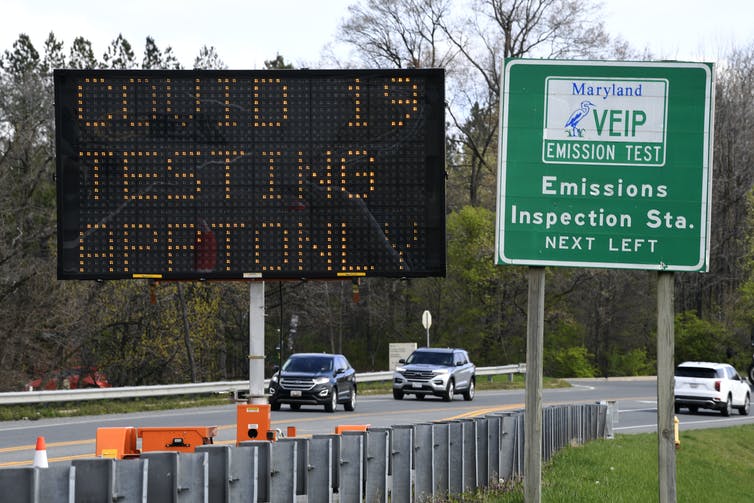
Sabrina Bracher / iStock via Getty Images Plus
Thankfully, most people who get COVID–19 don’t become seriously ill – especially those who are vaccinated. But a small fraction do get hospitalized, and a smaller fraction do die. If you are vaccinated and catch the coronavirus, what are your chances of getting hospitalized or dying?
As an epidemiologist, I have been asked to respond to this question in one form or another throughout the pandemic. This is a very reasonable question to ask, but a challenging one to answer.
To calculate the risk of hospitalization or death after getting infected with SARS-CoV-2 you need to know the total number of infections. The problem is that nobody knows exactly how many people have been infected by the coronavirus. So while it is very hard to estimate the true risk of dying if you are vaccinated and come down with COVID-19, there are some ways to better understand the risks.

AP Photo/Susan Walsh
Table of Contents
Counting infections
The first thing to consider when thinking about risk is that the data has to be fresh. Each new variant has its own characteristics that change the risk it poses to those it infects. Omicron came on quickly and seems to be leaving quickly, so there has been little time for researchers or health officials to collect and publish data that can be used to estimate the risk of hospitalization or death.
If you have enough good data, it would be possible to calculate the risk of hospitalization or death. You would need to count the number of people who were hospitalized or died and divide that number by the total number of infections. It’s also important to take into account time delays between infection, hospitalization and death. Doing this calculation would give you the true [infection] hospitalization or fatality rate. The trouble is health officials don’t know with certainty how many people have been infected.
The omicron variant is incredibly infectious, but the risk of it causing significant illness is much lower compared to previous strains. It’s great that omicron is less severe, but that may lead to fewer people seeking tests if they are infected.
Further complicating things is the widespread availability of at-home test kits. Recent data from New York City suggests that 55% of the population had ordered these and that about a quarter of individuals who tested positive during the omicron surge used a home test. Many people who use home tests report their results, but many do not.
Finally, some people who do get symptoms simply may not get tested because they can’t readily access testing resources, or they don’t see a benefit in doing so.
When you combine all these factors, the result is that the official, reported count of coronavirus cases in the U.S. is far lower than the actual number.

Mironov Konstantin / iStock via Getty Images Plus
Estimating cases
Since the beginning of the pandemic, epidemiologists have been working on ways to estimate the true number of infections. There are a few ways to do this.
Researchers have previously used antibody tests results from large populations to estimate the prevalence of the virus. This type of testing takes time to organize, and as of late February 2022, it doesn’t appear that anyone has done this for omicron.
[You’re smart and curious about the world. So are The Conversation’s authors and editors. You can read us daily by subscribing to our newsletter.]
Another way to estimate cases is to rely on mathematical models.
Researchers have used these models to make estimates of total case numbers and also for infection fatality rates. But the models don’t distinguish between estimated infections of vaccinated and unvaccinated individuals.
Research has shown time and again that vaccination greatly reduces one’s risk of serious illness or death. This means that calculating the risk of death is only really useful if you can distinguish by vaccination status, and existing models don’t enable this.
What’s known and what to do?
Without a good estimate of total cases by vaccination status, the best data available is known cases, hospitalizations and deaths. While this limited information doesn’t allow researchers to calculate the absolute risk an individual faces, it is possible to compare the risk between vaccinated and unvaccinated people.
The most recent data from the Centers for Disease Control and Prevention shows that hospitalization rates are 16 times higher in unvaccinated adults compared to fully vaccinated ones, and rates of death are 14 times higher.
What is there to take away from all this? Most importantly, vaccination greatly reduces the risk of hospitalization and death by many times.
But perhaps a second lesson is that the risks of hospitalization or death are much more complicated to understand and study than you might have thought – and the same goes for deciding how to react to those risks.
I look at the numbers and feel confident in the ability of my COVID-19 vaccination and booster to protect me from severe disease. I also choose to wear a high-quality mask when I’m indoors with lots of people to lessen my own risk even further and to protect those who may be unable to get vaccinated.
There have been many lessons learned from this pandemic, and there are many things researchers and the public still need to do better. It turns out that studying and talking about risk is one of them.
![]()
In the past, Lisa Miller has received funding from the Centers for Disease Control and Prevention, mentioned in this article.























